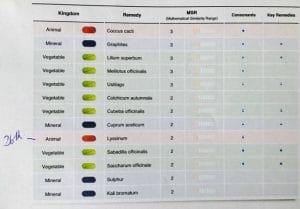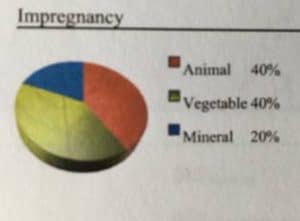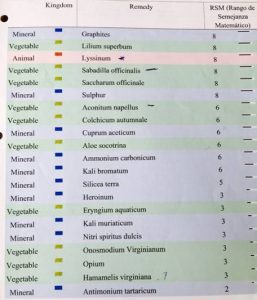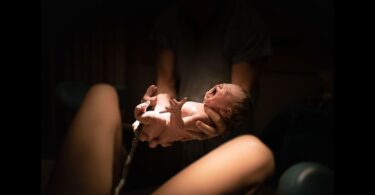Homeopathy treatment balances our physical, emotional, mental and spiritual energies. Classical Homeopathy uses symptoms to find a remedy to balance our energies, but there is another standard (or similar) called The Huma Method (Candegabe’s Algorithm)1. A mathematical paradigm is proposed in the Huma Method using a numerical code as a new standard: it solves most of the problems inherent in our repertories.
Rubrics sizes are increasing as new provings are published and added to the rubrics. Many new remedies have been proven and their rubrics have not, as yet, been added to the repertories. The algorithm uses a different approach in finding similarity between substance and people and does not make any reference to signs and symptoms at all. The algorithm is not a philosophy but a new and exciting tool for homeopaths. The case still needs to be taken with the same amount of care and then the algorithm chart can be studied to help find the best remedy.
After a period of experimentation with the Canedgabe’s Algorithm innovative tool, I have found a way to use it in my practice. The aim of this article is to explain how to find the simillimum from the algorithm result, and to demonstrate how it works with two examples: both Lyssin cases.
In another article published in Homeopathy for Everyone, May 2014 – “Using the Algorithm to Fine Tune Homeopathic Repertorisation”. 2 I have described three cases using the algorithm result and demonstrated how a remedy can be selected.
The personal information of a client (name, nick name, initials, date of birth, country of birth) is translated into a phonetic code or pattern using the international phonetic alphabet. It compares the numero-phonetic code of the latin name of homeopathic remedies to the phonetic code of the clients translated personal information -“Like cures Like”. A readout chart lists remedies that correspond to the patient’s personal information. The chart is produced from a Normal Distribution Curve 3 and a Curve of Asymmetric Distribution 4.
The algorithm is a new mathematical approach to a paradigm of homeopathy, created by Dr. Marcello Candegabe 5 and his team. Dr Marcelo Candegabe is a homeopath from Escuela Medico Homeopathic Argentina Tomas Pablo Paschero 6 and Director of the Universidad Candegabe de Homeopatica, Argentina. 7
The code was calculated using a baseline of cured cases. It is simply a mathematical probability algorithm. The chart contains thirty to forty remedies which are graded according to their correspondence to your client’s details. They are graded according to the kingdom, and now a Combined Analysis is on the chart with grading for consonant, vowel and key remedy parameters.
The remedies obtained from the algorithm result are ranked from nine to two and indicate the rank or level of mathematical similarity between the substance and case under analysis. The algorithm also represents a graph called the pregnancy, which indicates the most likely substance of the homeopathic remedy (animal, plant, mineral, imponderable).
The new method was created after Dr Marcello Candegabe, a homeopath from the Argentina School of Homeopathy, 6 met with Hans Peter Durr, the well-known physicist from the Max Plank Institute. Durr reasoned that there must be many codes that relate medicines to patients.
After the meeting Candegabe put together a development team 6 including 20 homeopaths, two mathematicians, a statistics engineer, an epistemologist, a linguist, a quantum physicist, a Latin expert and a programming expert at the University of Buenos Aires. They studied the most stable parameters which could be as far from human subjectivity as possible. It took them 3 years before they were satisfied with the results and in 2008 the Algorithm was made available online for the first time.
Initially the Huma method was proven in over 900 cases 6, using more than 1000 remedies. Over 400 cases cured with classical homeopathy were analysed as control cases.
To date there are 15,000 cases analysed. Homeopaths from all over the world (25 countries) are using this method including those in Italy, USA, UK, Australia, Ecuador, Mexico, Brazil, Japan, Greece, Uruguay, Chile , Norway and Argentina.
I use my repertorisation results and then I compare them with the algorithm result to help find the medicine for the case. Many new remedies or little known remedies come up in the algorithm result and you may find the simillimum not to be in the repertorisation. A study of the new remedies is needed. You can draw on information from different well-known homeopaths to help you see the remedy in the result. I have had amazing results with remedies that came up in the algorithm analysis. Without the algorithm, I would never have thought of these remedies.
Robert Bannan published an article in Homeopathic Links Winter 2013 8. He states how important it is to use the correct spelling with the correct vowels and to use nicknames as well as birth names. It is more difficult to get a result with Slavic names and Chinese names because there are incompatibilities with the Latin Base. Robert has found that it is unusual for a person to need a remedy that scores less than 6. I have not necessarily found that, because I have occasionally used a remedy that was a successful remedy and it was at the bottom of the list. In Spring 2014 Robert Bannan gave the first training on the algorithm in New York to help homeopaths come to grips with the subtleties of the system.
Dr Eliya Kostova MD, an advocate of Alternative and Complementary Medicine, was a speaker at an International Homeopathic Seminar in Hong Kong in April 2016. She spoke about the mathematical approach of the Homeopathic paradigm/ Huma Method, the Homeopathic Algorithm. Eliya Kostova is a medical doctor who specialises in Internal Medicine, Economy of Health and is a Master Homeopath accredited by the Association of Homeopathic Physicians in Bulgaria and the European Committee for Homeopathy.
Two Lyssin Cases Using the Algorithm Tool
Case 1
Female age 18 (see charts 1 and 2)
Medication: Anti depressants
Depression since 13 years old, crying, sleepy, difficulty getting out of bed.
When a small child she was hyperactive and possessive. She would never allow her mother to talk to anyone without disruption. She can be very rude to anyone when she gets depressed. Sensitive to noise. Her hands tremble. At age 13 she developed a lump in her throat and felt that her throat closed up. She had nausea and her whole body was sore. As a child she used to bite, hit and kick.
She had eczema as a child behind her knees and her arms. When walking, she felt she had to walk in between the gaps.
Fears: drowning, darkness, clowns.
She saw spirits sometimes.
She had psoriasis on her left scalp with scaliness in her ear.
She had screaming nightmares after eating chicken but doesn’t remember the dreams. She craves chocolate and oranges.
The rubrics used were:
Rudeness, Weeping, Sleepiness, Sadness, Biting, Anger, Trembling hands, Desire chocolate, Choking Constricting in throat, Lump in throat, Eruptions extremities, Compulsive disorders
See Chart 1-The Impregnancy Symmetry chart demonstrates that she is 50% likely to respond to an animal remedy.
See Chart 2- There were two animal remedies in her chart both on the second page: Coccus Cacti and Lyssinum. Comparing the rubric analysis with the chart, Lyssin (26th Remedy on the list) was an obvious choice.
Remedy: Lyssin M
Four months later:
She stopped the anti- depressants 1month after taking the remedy and felt reasonably stable since. She stopped crying and only feels sad sometimes. She isn’t sleepy anymore and gets out of bed easily. She occasionally wakes with anger. Her trembling hands improved but are now worse again. The nightmares are less but she had a dream about being raped. Scaliness in her ear has improved. She has stopped being obsessive about food and is now eating a healthy and balanced diet. She said that her body image has improved.
She mentioned that she got a tattoo to cover a scar where she had cut herself. She hadn’t told me about that in the first consultation.
11months later her mother called and said she was well.
Chart 1
Chart 2
Case 2
Female Age 34
Sinusitis all her life, endometriosis in left ovary, migraines, constipation as a child, heavy sensation in her body. Her father used to hit her mother and she used to hide. She gets angry with her mother and then quickly apologises (she told me this in the second consultation). She hates the sound of dripping water, it really annoys her ( she told me this symptom after she took Lyssin). Pain right shoulder. She plays with her fingers.
The rubrics used were:
Nose Discharge watery, Coryza, Sneezing aggravated in the morning, Eyes discharge, Eyes swelling lids, Sensitive doors, Violent effects, Weeping, Constipation difficult stool, Pain left ovary, Pain right shoulder, Gestures with hands, Remorse repents quickly, Irritability on hearing dripping water.
See Chart 3- The impregnancy chart demonstrates that she has a 40% chance of responding to an animal or a plant remedy.
Remedy: Sabadilla 30
2 weeks later
I tried Sabadilla (4th on the algorithm chart and a plant remedy) after taking the first consult and she did improve slightly. I wasn’t satisfied with the result so when she told me about how she always had to immediately apologise after screaming at her mother, I gave her Lyssin 30.
Remedy: Lyssin 30
She rang 1 week later she said her sinus had improved after an initial aggravation, she felt lighter, lifted, motivated and less heavy in her body.
After 3 weeks her sinus was 70% improved. During this consultation she told me that she could not stand the sound of dripping water. She had had only one headache; her right shoulder was better and she was making decisions easily.
Remedy: Lyssin 30
4 weeks later:
Bad back came and went. No sinus problems for the first time in her life. One headache, bad period pain. She realised that she didn’t need to save her mother and was only responsible for herself. Playing less with fingers.
Remedy: Lyssin M after her period.
Repeat if any symptoms return.
Chart 3
Chart 4
I encourage homeopaths to try the algorithm. The Huma Method can make it easier for the homeopath to make a better remedy choice and will bring up remedies to consider which normally wouldn’t be in your thoughts.
The Candegabe Community is hoping to develop and realise the potential of this new tool. The algorithm can be used with other tools and systems including Sankaran, 9 Scholten, 10 Liz Lalor, 10 Vermuelen, 11 Alistair Gray 12 etc.
This new tool can be used for prescribing and in the development of clinical material medica for the little known and rarely used remedies. It makes it easier for the homeopath to make a better remedy choice.
References
- 1. Candegabe Algorithm. About the Algorithm [Internet]. The Huma Method. [cited 2015 Feb 2] Available from:
- Campbell Rhonda. Using the Candegabe Algorithm to Fine Tune Homeopathic Repertorisation. Homeopathy For Everyone [Internet]. 2014[cited 2014 May]. Available from:
- Normal Distribution. Carl. F. Gauss. [Internet]. cited 2015. Available from:
http://en.wikipedia.org/wiki/Normal_distribution
- Curve of Asymmetric Distribution. Emil J. Gumbel. [Internet]. cited 2015. Available from:
http://en.wikipedia.org/wiki/Gumbel_distribution
- Homeopathy in the year 2050. Presented at the Liga Homeopathica Internationalis Congress. 64 degree LMHI Warsaw Congress 2009. Timeless Quality Homeopathy. Author Dr. Marcelo Candegabe with Dr. Gustavo Cataldi.
- Dr. Marcelo Candegabe research team .“Escuela Médica Homeopática Argentina. 2005.[Internet] cited 2015. Available from:
http://escuelapaschero.com.ar/?cat=70 Método HUMA is where the group is
presented. 20 homeopaths
Luís María Grau – Statistics Engineer
Diego Vila – Epistemologist & BA in Philosophy and Letters
Ida Deschamps – Latin Expert
Victoria Paternostro – Mathematician
Lic. Enrique Yantorno – Programing expert
Raúl Fernandez Calvo – Mathematician & Quantum Physicist
- Dr. Marcelo Candegabe. [Internet]. Cited 2015. Available from:
- Bannan Robert. 21st Century Homeopathy. Homeopathic Links Winter 2013 [cited October 2104] Vol 26: 1-8. Available from: Thieme Medical and Scientific Publishers Private Ltd
- Dr Rajan Sankaran. MD(Hom).[Internet].cited 2015.
- Jan Scolten. MD. Homeopath. [Internet]. cited 2015. Available from:
- Liz Lalor, Homeopath. [Internet]. Cited 2015.
Available from: https://www.facebook.com/liz.lalor.9
- Frans Vermuelen. Homeopath. [Internet].cited 2015.
- Alistair Gray. Homeopath. DSH (UK) PCH (UK) PCHom (Malaysia) ADH (NZ) BAHons (NZ) AHA. ATMS. ARoH (Aus) RSHom (UK). [Internet] cited 2015. Available from: http://www.wholehealthnow.com/bios/alastair-gray.html









What has the name and nicknames of patients got to do with the diseases or remedies ? is the question.
Except for inclusion of newer remedies in the repertory this method seems highly unscientific. Since case taking has to be done with utmost care as in normal repertorisation methods, the homeopath can passively be biased towards most likely remedies and the similimum. A fresher would not be able to use this algorithm method satisfactorily.
That makes the method superfluous.
If Masters like Hahnemann, Boenninghausen, Kent and Hering etc have declared that there’s no shortcuts to prescribing, further attempts to find shortcuts are futile
Also mathematically speaking, prescribing is an inverse problem. we are actually reconstructing the remedy picture from one of its own outcomes with fragments Of The total picture available in each case. as such it is a NP problem in computation complexity theory.
Hence there can’t be any satisfactory algorithms. it is a mathematical impossibility.
pardon me if I am disappointing